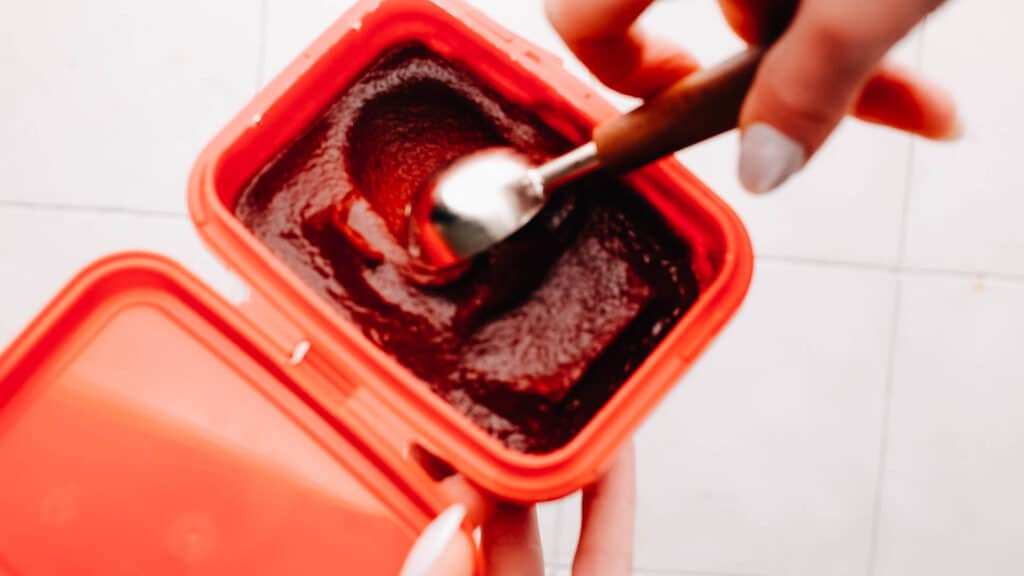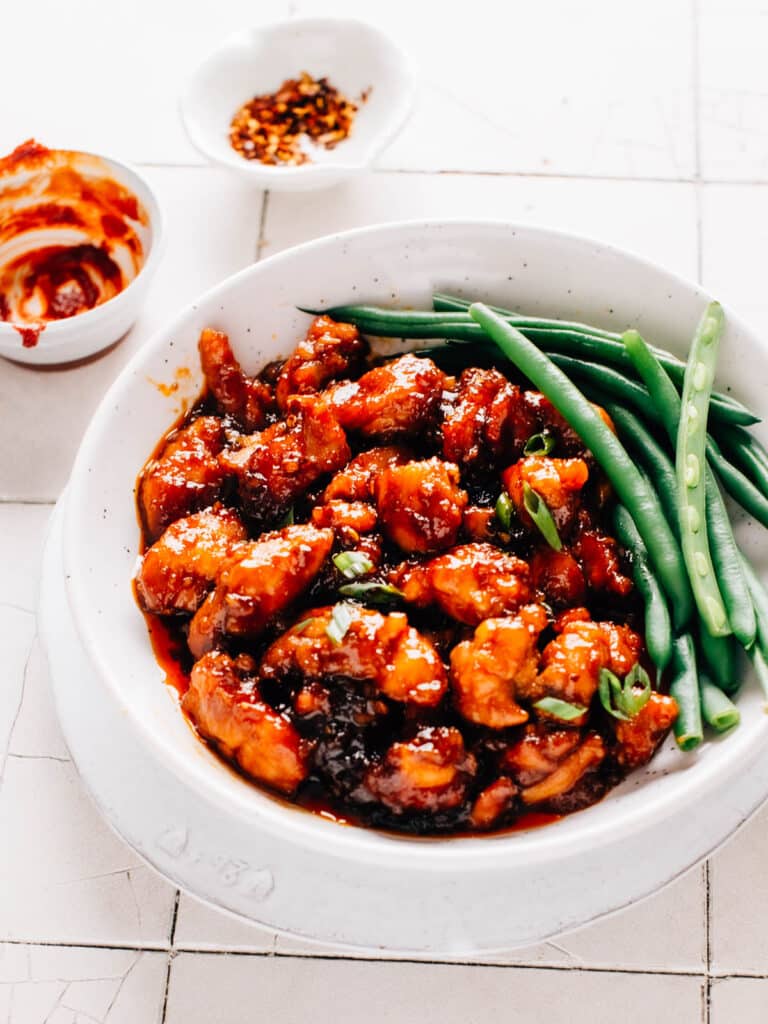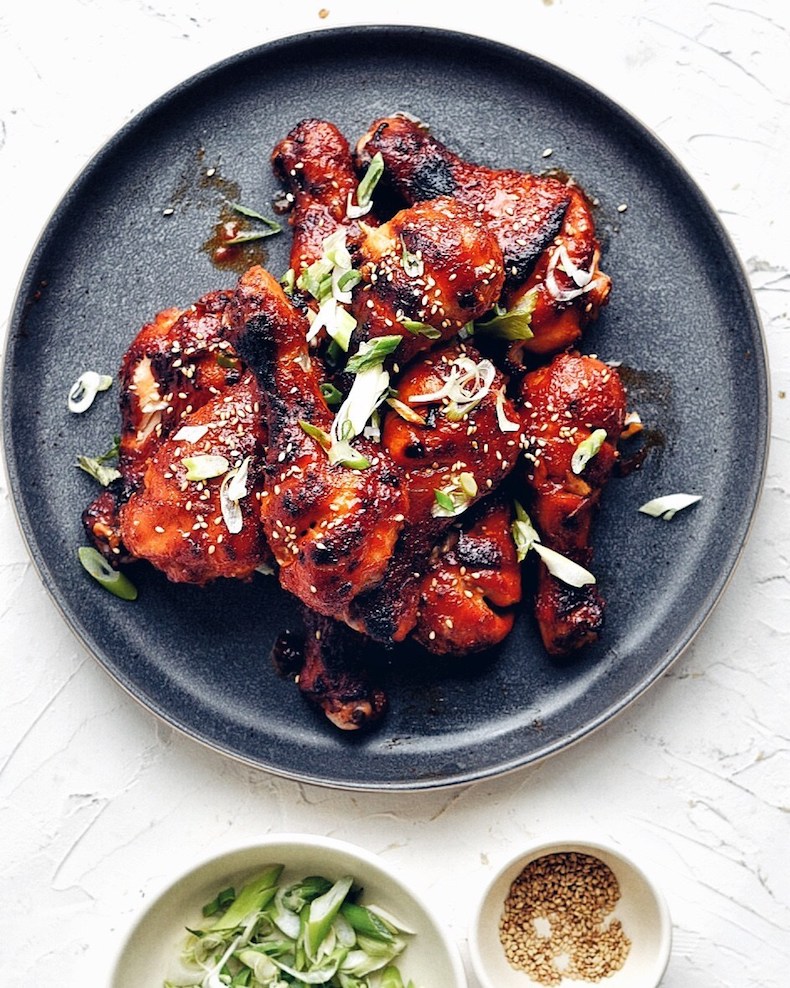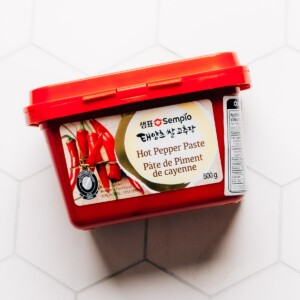The Best Gochujang Substitute (Authentic Taste!)
Feb 02, 2024
Here’s my easy gochujang substitute (that tastes really close to the real thing!) plus the best store-bought options.

Best Gochujang Substitute: Quick Answer
The short answer is that the most authentic, best gochujang substitute is a combination of miso paste, hot sauce and sugar.
Read on for the full details on why this works, specific quantities, plus a few ready-to-use options you can find at the store for when real gochujang is not available.
What Is Gochujang?
Gochujang is not a hot sauce, it’s a sweet, spicy, slightly funky paste made with fermented rice and soybeans as well as chilli peppers.
Gochujang is a staple in Korean cuisine. It is loved for its bold, savory, sweet, and spicy taste profile.
The primary ingredients in gochujang include red chili powder, glutinous rice powder, fermented soybean powder, and salt.
Is Gochujang really spicy?
Gochujang is known for its spiciness, but it also has a complex flavor profile that includes sweetness and umami. It is certainly not super hot. Depends on your tolerance for chili, I guess.
The level of spiciness can vary among different brands and recipes, but in general, it adds a only a moderate level of heat to dishes.

What Does Gochujang Taste Like?
Gochujang is a thick, brick-red paste with a rich umami taste, a hint of sweetness, and a lingering heat.
The mixture is traditionally left to ferment in earthenware pots for months, allowing the natural fermentation process to enhance the flavors.
How Is Gochujang Traditionally Used?
Gochujang is traditionally used in various ways in Korea:
- Marinades and Sauces: Gochujang is a key ingredient in many Korean marinades and sauces, adding depth of flavor and a spicy kick. It is often combined with other ingredients like soy sauce, garlic, and ginger to create savory and sweet coatings for meats, especially in dishes like bulgogi (marinated grilled beef). Also, check out my sticky gochujang chicken recipe!
- Stews, Stir-fries and Soups: Gochujang is frequently used in Korean stews and soups, such as the popular dishkimchi jjigae. It adds not only spice but also a rich umami flavor to the broth, enhancing the overall taste of the dish.
- Bibimbap Sauce: In bibimbap, a popular Korean mixed rice dish, gochujang is often mixed with other condiments to create a flavorful sauce. This sauce is then drizzled over the rice and assorted vegetables, providing a spicy and savory element to the dish.
- Dipping Sauce: Gochujang can be used as a dipping sauce for various snacks or grilled meats. When diluted with a bit of vinegar or soy sauce, it becomes a versatile dipping accompaniment.
- Base for Kimchi: In some kimchi recipes, gochujang is used as part of the seasoning mixture, contributing both spice and a fermented flavor to the iconic Korean side dish.

The Best Gochujang Substitute (Homemade)
The most authentic gochujang replacement combines miso paste and sriracha with a little pinch of sugar.
If you try to just swap in another Asian sauce like sriracha or sambal oelek as a 1:1 gochujang substitute, your dish will be spicier and more acidic than intended. Hot sauces contain vinegar, and gochujang does not.
You’ll be missing out on the sweetness as well as the rich umami flavor of the fermented rice and soy beans as well.
For a truly close homemade gochujang substitute, swap in a combination of:
- White miso paste – for the funky fermented flavor.
- Sriracha – for the heat.
- Sugar – for the sweetness.
This is my favorite gochujang substitute. The ingredients are easy to find; all you need to do is mix the ingredients together into a single paste.

The Best Store-Bought Gochujang Substitutes (Store Bought)
Here are 5 easy-to-find and ready-to-use substitutes. You’ll need to play around with the quantities to get the flavors right in the dish originally intended to be made with gochujang (both in flavor and texture).
- Ssamjang: This is another Korean condiment, often considered a cousin to gochujang. It combines fermented soybean paste with chili paste and other flavorings, offering a rich and savory profile.
- Thai red curry paste: While not the same as gochujang, Thai red curry paste or Thai chili paste can be a decent substitute due to its spicy and flavorful nature. Adjust the quantity based on your preferred level of heat.
- Harissa paste: This North African chili paste, made with a blend of chili peppers, garlic, and various spices, can provide a spicy kick similar to gochujang. It has a distinct flavor, so it might alter the taste of the dish slightly.
- Chili garlic sauce: This condiment is a blend of chili peppers and garlic in a vinegar base. While not fermented like gochujang, it can offer a quick and spicy addition to dishes.
- Doenjang: Did you know that you can replace Gochujang with Doenjang, a fermented soybean paste? Although Doenjang boasts a robust and savory taste, it lacks the spiciness found in Gochujang. Many recipes that call for Gochujang, such as stews, soups, and marinades, can be prepared using Doenjang as a suitable alternative when Gochujang is unavailable.
What Not To Use
While some substitutes can offer a similar spicy kick, certain alternatives may not capture the unique flavor and characteristics of gochujang. Substitutes that might not be suitable include:
- Hot sauce: While hot sauce can add heat to a dish, it lacks the depth and fermented complexity of gochujang. The flavor profile is often simpler, and it may not provide the umami richness that gochujang contributes.
- Tomato paste: Although tomato paste adds thickness and a hint of sweetness, it lacks the spiciness and distinctive taste of gochujang. Using tomato paste as a substitute would significantly alter the intended flavor of the dish.
- Indian-style Curry Paste: While curry paste can bring spiciness and depth, it has a different flavor profile dominated by curry spices. This can significantly change the taste of the dish and might not be suitable for Korean recipes. Cumin for example (a prominent flavor in Indian food), is not usually included in Korean recipes.
Choosing a substitute depends on the specific recipe and desired flavor, but it’s essential to consider the unique qualities of gochujang that contribute to its distinctive taste in Korean cuisine

FAQ
Are you just skimming through this post? No problem; here are some frequently queried points around gochujang substitutes:
Is gochujang similar to sriracha?
No, gochujang and sriracha are distinct condiments with different flavor profiles. Gochujang is a Korean fermented chili paste full of sweetness and umami. Sriracha is a Thai hot sauce with a simpler, tangy, and garlicky flavor. The look similar (kind of) but don’t have similar flavors.
What does gochujang taste like?
Gochujang has a rich, savory, and spicy flavor profile. It is characterized by a deep umami taste, a hint of sweetness from fermented ingredients, and a moderate to high level of spiciness. The fermentation process contributes to its unique and complex taste.
Is gochujang the same as hot pepper sauce?
Gochujang is not the same as hot pepper sauce. While both are spicy condiments, gochujang is a Korean fermented chili paste with a thicker consistency and a more complex flavor. In contrast, hot pepper sauce is often thinner and focuses primarily on heat generation.
Can I substitute gochujang for Thai red chilli paste?
While they share some similarities, gochujang and Thai red chili paste have distinct flavors. Gochujang is thicker, fermented, and has a richer taste, while Thai red chili paste tends to be thinner and focuses on the heat. Substituting one for the other may alter the flavor profile of the dish.
Is hot pepper paste the same as gochujang?
Hot pepper paste is a general term referring to various spicy condiments. Gochujang is a specific type of Korean hot pepper paste, distinguished by its thick consistency and fermented flavor. Other hot pepper pastes may differ in ingredients and taste.
Can you substitute gochujang with gochugaru?
Gochujang and gochugaru are related but serve different purposes. Gochujang is a fermented chili paste, while gochugaru is a coarsely ground red chili pepper powder (see “chili powder vs cayenne pepper) .
Is Gochujang gluten-free?
The gluten-free status of gochujang depends on the specific brand and ingredients. Traditional gochujang recipes often include glutinous rice powder or wheat flour, which contain gluten.
However, gluten-free versions of gochujang are available, so check the product label if you have gluten sensitivities.
Korean Recipes You’ll LOVE
- Sticky Gochujang Chicken
- Sticky-Spicy Korean Chicken Wings
- Grilled Korean Short Ribs
- Slow Cooker Korean Short Ribs

Best Gochujang Substitute
Ingredients
- ½ tablespoon miso paste
- ½ tablespoon sriracha
- ½ teaspoon sugar
Instructions
- Measure out 1/2 tablespoon of miso paste.
- Add 1/2 tablespoon of sriracha to the miso paste.
- Sprinkle in 1/2 teaspoon of sugar.
- Mix the ingredients thoroughly until you achieve a smooth, well-combined paste.
- Use the substitute as directed in your recipe, matching the quantity of gochujang required.
Notes
Nutrition
Nutrition information is automatically calculated, so should only be used as an approximation.








